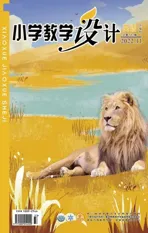《新标准英语》(三起)三(上)Module 8 Unit 1 Is it a monster?
2022-12-21沙振华
文|沙振华 孙 杰
教学过程
Step 1. Warming-up
1. Greeting. / Sing a song:
What’s this?
2. Freely talk: What’s this?
设计意图:通过歌曲演唱营造浓厚的英语学习氛围,并借助学生身边的文具进行“What’s this?”的真实语言交流,巩固旧知,为新知学习做好铺垫。
Step 2. Presentation
1.(出示课文中公园图片)Look! What’s this? Guess:What’s in the park? Listen!
设计意图:通过出示公园图片,让学生借助听音、看图等不同形式猜测公园里都有什么,调动学生多种感官参与,最后出示风筝的一角让学生猜测,激发学生参与的热情,自然进入新知的学习。
2. Watch and find the answer.
S: It’s a kite.
T: Who is flying the kite?Yes, Sam is flying a kite in the park. What does he say?(出示Sam: Look! My new kite.)通过hi,fine,nine,five,kite 进行自然拼读练习,渗透发音规律并学习单词new。

3. Sam says: My new kite.What does Daming ask?
S: Your cat or your kite?
T: What’s the meaning of“or”? Why does Daming ask like this?
设计意图:引导学生读图,获取图片信息,并分析隐含的信息:大明这么问,一是因为Sam 和Daming 隔的距离比较远,听不清楚说了什么,另外cat 和kite 的发音有些相似,不太容易分辨。
4. T: Is it a cat? Is it a kite?
S: ...
T: What does Daming say?
S: It’s a cat kite.(出示bird kite, dog kite, panda kite, chameleon kite 让学生尝试描述)
5. Listen and imitate. Then read in roles.
T:Is Sam happy? Why? What else have you found? Why?
设计意图:引导学生仔细观察图片,分析隐含的信息:Sam 不开心是因为风筝线断了,图一有小老鼠,而图二没有了,可能是他把风筝当成了真的猫而被吓跑了。

6. T: Daming sees a cat kite in the park. What about these two girls? What do they see?Look! Can you ask a question?Can you guess? Is it a...?
7. T: Let’s watch and check your answer.
8. T: Have you got the answer? What’s that?
S: It’s a kite.
T: Is it a cat kite?
S: No. It’s a monster kite.
(借助单词teacher 学习monster渗透发音规律)

设计意图:学生带着自己的猜测整体观看动画,获取有效信息,并学习新词monster。
9. T: Look at the two girls.Are they happy? Why?(Oh, they think it’s a monster. They’re scared.) But at first sight, do they know it’s a kite?
(出示文本第一幅图)Look!What’s that? The girl says: It’s a... I don’t know.(借助window,yellow 学习新单词know)
设计意图:引导学生观察图片,获取图片隐含信息,自然进入下一步的学习。
10. T: They don’t know what it is. How do they express the guesses? Let’s have a look!
T: Have you got the answer?How do they guess? They use the sentence: Is it a...?
(1)Look at the cat. How do they guess? Can you try it?
T: Listen!Is it a cat? No,it isn’t.
(2)(dog)T: What about the dog? Who wants to try?
(3) (Monster)Is it a dog?
Is it a cat? Who can try it?S: Is it a monster?
T: What does the girl think?She says: Yes, it is!
(4)T: Why does she say like this? (They’re scared. They think it’s a monster.) If you were them, what would you say?
S: Help! (Act it out with students.)Who wants to try it?
(5)T: They shout“Help!”Help is very useful in English.Look! When they’re in danger.What would they say?

Remember: When we’re in danger, we can shout,“Help”!
设计意图:学生带着问题再次观看动画,体验女孩用什么方式猜测不明物体,并进行小步子操练。用Role-play 的活动体会人物情感,激发学生参与课堂活动的积极性,并借助help 进行英语文化介绍和安全教育。
11. T: Let’s have a look.From the very beginning. How do they express the guesses? Read in roles.
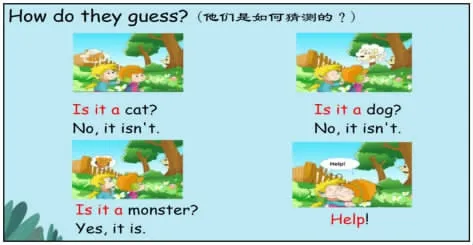
12. T: You did a very good job. They think it’s a monster,They are very scared. But is it a real monster? How do you know that? Let’s look!(播放动画最后一部分)Oh,it’s a kite. Is it a cat kite? Who is flying the monster kite?
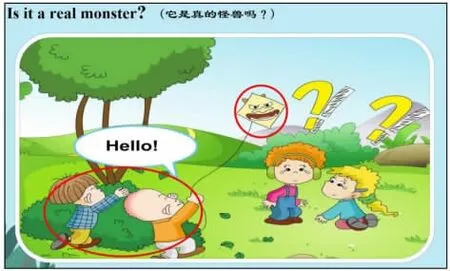
13. T:At the very beginning, the kite is behind the tree.Guess! Who else is hiding behind the tree? Why?

Look at these girls. They’re crying. They think it’s a mon ster. Are there real monsters in the world? What do you want to say to them? What do you want to say to Sam and the boys?

设计意图:通过观看动画最后一部分,引导学生对图片信息进行挖掘,揭示主题意义,让学生明白世界上并没有怪兽,对被吓坏了的小女孩们和搞恶作剧的小男孩们,同学们可以畅所欲言,给他们一些建议。在师生交流的过程中培养学生的高阶思维。
14. Play a game.(Say as quickly as you can.)
15. Listen and imitate. Let’s act out the dialogue.
Step 3. Practice and production
1. T: They see a kite in the park. But they guess it’s a monster. What about you? What can you see? Let’s guess and say. You can guess like this.(师生示范如何运用word bank 和句子进行猜测)
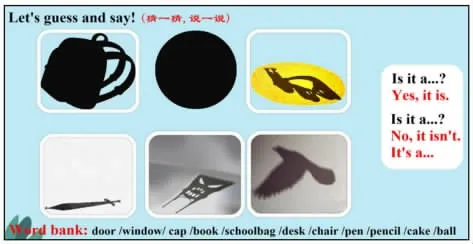
T: Picture 1: Who wants to guess?(生问师答)
Picture 2: This time I ask you:Is it a ball?
2. T: I have four pictures for you. You can choose one and guess in pairs. Then act it out.
设计意图:通过看影子猜物品的活动,为学生创设真实情境和信息差,引导学生初步尝试运用所学语言。
3. T: You can guess them from their shadows. I think you are super. What about the boy?What does he see? What will he think?
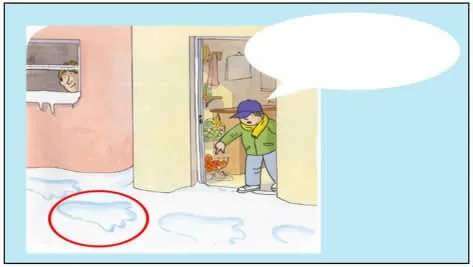
4. T: What’s that? Can you guess? Is it a cat? Why?

设计意图:通过教师引导,学生观察和分析猫和鸟的脚印形状,能够得出不是它们的脚印的结论,为进一步的思考和讨论提供思维范式。
5. T: So what’s that? Let’s think and discuss.
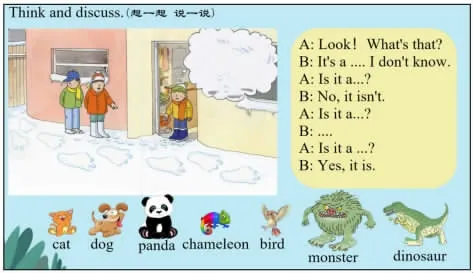
6. Show time.
T: Great imagination! But is it a monster/ dinosaur? What’s that? Do you want to know? Let’s read the picture book.

设计意图:学生针对大脚印展开猜测和讨论,在猜测的过程中激活学生的发散思维,最后揭示谜底,再一次印证了“There’re no monsters in the world. Don’t scare yourself ”的主题。而“Dinosaurs are an extinct species.”也激发了学生的科学探究意识,在这种跨学科的融合中,学生既培养了高阶思维,又强化了科学素养。
7. T: After class, can you make your own picture book?

设计意图:创编新的绘本,可以充分发挥学生的想象力和创造力,充分整合所学语言知识,提高学生综合语言运用能力。
Step 4. Summary
T: What have you learned in this class?
What ideas have you got from the text?
Step 5. Homework
1. Read and recite the dialogue, then act it out next class.
2. Read the picture book,then make your own picture books.
We’ll show it next class.
